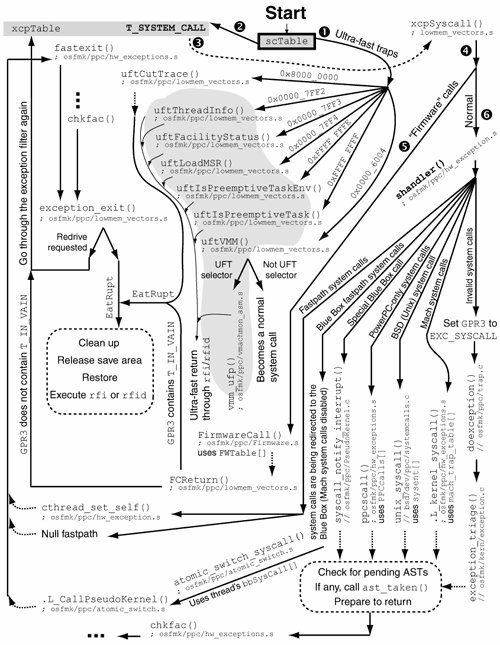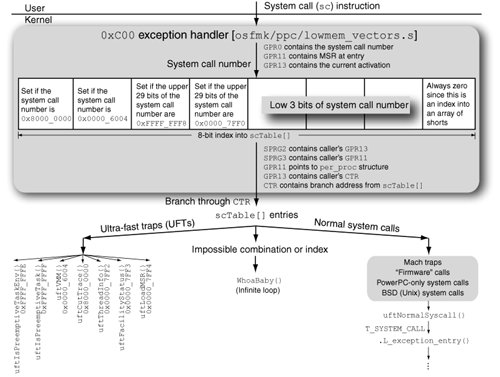Section 6.6. System Call Processing
6.6. System Call ProcessingIn traditional UNIX, a system call is one of a well-defined set of functions that allow a user process to interact with the kernel. A user process invokes a system call to request the kernel to perform one or more operations on its behalf. The kernel may perform the requested operations after validating input parameters to the system call, if any, and perhaps several other checks. A system call may involve exchange of datatypically at least a return valuebetween the kernel and the user process. Our definition of a Mac OS X system call is a function callable through the sc instruction. Note that it is legal to use the sc instruction from within the kernel. It is also possible to directlyfrom within the kernelcall an internal function that implements a system call. Nevertheless, a typical invocation of a system call is from user space. Since the Mac OS X kernel is an amalgamation of entities with quite different personalities and characteristics, it is interesting to ask which portions of xnu these system calls provide entry to: BSD, Mach, the I/O Kit, or something else? The answer is: all of them, and more. Based on how they are processed, Mac OS X system calls can be categorized as ultra-fast traps, firmware calls, and normal system calls. Figure 612 shows the key code paths involved in system call processing. The figure should be followed beginning at the "Start" label. Figure 612. Details of system call processing in Mac OS X We can also categorize Mac OS X system calls based on what they do, that is, based on their flavors. The following categorization also captureslargelythe division based on the kernel subsystems that these system calls provide access to.
As shown in Figure 612, the details of how each system call category is handled in the kernel differ. Nevertheless, all system calls are invoked from user space via the same basic mechanism. Each category uses one or more unique ranges of system call numbers. In a typical invocation of any type of system call, the calling entity in user space places the system call number in GPR0 and executes the sc instruction. These statements must be qualified with the following points to avoid confusion.
The kernel's hardware vector for the system call exception maps the system call number in GPR0 to an index into the first-level dispatch table containing handlers for various types of system calls. It then branches to the call handler. Figure 613 shows details of this mapping. Figure 613. Mapping an incoming system call number to an index in the first-level system call dispatch table The first-level dispatch tablescTablealso resides in low memory. As Figure 613 shows, it can map ultra-fast system calls to their individual handlers, route all non-ultra-fast valid system calls to a normal dispatcher, and if an impossible index is encountered, it can send the call to WhoaBaby. The dispatcher for normal system calls sets the exception code in GPR11 to T_SYSTEM_CALL. Such calls, including BSD and Mach system calls, are next processed by .L_exception_entry(), the exception-handling code common to most exceptions. As shown in Figure 611, .L_exception_entry() branches to xcpSyscall to handle the T_SYSTEM_CALL exception code. xcpSyscall hands over the processing of most system calls to shandler() [osfmk/ppc/hw_exception.s].
|
EAN: 2147483647
Pages: 161